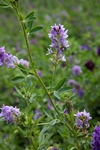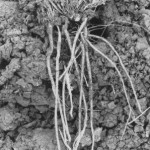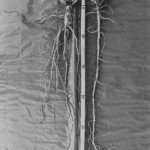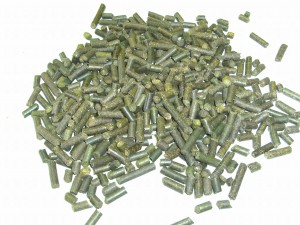Alfalfa
 Natural healthy forage feed
Natural healthy forage feed
Alfalfa is a fodder crop that has been used as a cattle fodder for over 2000 years. Alfalfa (L. Herbe Medica) was foddered to cavalry-horses and draught-horses of the ancient Greeks and Romans and it is recognized as en excellent fodder crop today.
In comparison to other fodders, Alfalfa is a natural and healthy forage feed containing one of the best sources of concentrated proteins, vitamins and minerals. As Alfalfa is very digestive, it can also be used as an additional fodder for weak and recuperating animals.
Alfalfa is a native plant of Persia. In the seventeenth century people introduced this fodder crop in Northern Africa, where it received the Morian name ’Alfalfa’. The name ‘Lucerne’ is probably derived from the valley of Lucerna that is situated in Northern Italy.
Alfalfa can be grown practically everywhere. It prospers in subtropical areas, but it thrives in northern countries too.
It has long roots penetrating the soil and this is one of the reasons it grows excellent on the marine clay of the Netherlands.
Cows-horses-sheep-goats-small cattle
Breeding performance, milk, meat or a combination of these aims are often the central focus when it comes to the animals mentioned above. To get the best results good fodder is important because it stimulates the growth and the health of the animals.
Oldambt Luzerne Contains a lot of micro-nutrients, lasting protein, digestible fibres and energy to provide a safe, natural and healthy fodder. It can be used as a principal fodder or as a supplement to the other fodders.
| Alfalfa | |
| Dry matter | 91,3% |
| Calcium | 1,6% |
| Phosphorus | 0,3% |
| Oil | 2,5% |
| Crude protein | 17,0% |
| Crude protein, digestible | 12,8% |
| Fibres | 29,5% |
| Ash | 9,4% |
| Energie, digestible | 10,0 MJ/kgDM |
Minerals and trace elements Calcium is essential for the structure of teeth, hoofs and bones. Bone contains between 9 and 10 percent calcium. Calcium is not only important for the skeleton but it is also essential for the function of nerves and muscles. The proportion of calcium and phosphorus in an animal is 1,7:1. Fresh grass and hay derivate from grass have this proportion too. Oats however may have a proportion of 1:6. Without additional calcium the body will then be using bone-calcium, which may have dangerous consequences for the animals.
Oldambt Luzerne Contains a concentration of calcium which is three times higher in comparison with grass. The proportion of calcium and phosphorus is 5:1. In a combination with grains, 1 kilo Alfalfa can compensate the shortage of calcium in 2 kilo’s of oats. This way no calcium-supplement is needed. Alfalfa is a natural source of calcium: a contribution to the skeleton and a supplement to other fodders. It contains the trace element cobalt too, which enables the animals to make their own vitamin B12.
| Minerals | % |
| Calcium | 1,60 % |
| Chlorine | 0,46 % |
| Phosphorus | 0,30 % |
| Kalium | 2,10 % |
| Magnesium | 0,30 % |
| Natrium | 0,08 % |
| Trace elements | mg/kg product |
| Fluor | 11,0 |
| Cobalt | 0,1 |
| Copper | 9,0 |
| Manganeze | 33,0 |
| Molybdene | 0,6 |
| Nickel | 1,6 |
| Selenium | 0,3 |
| Iron | 250,0 |
| Zinc | 22,0 |
| Sulphur | 2000,0 |
Proteins and amino-acid Protein is essential for all body functions. Animals need even extra protein when they are with young, suckling, growing-up, weak or recuperating. These animals need a well digestive protein with a good amino acid balance.
A large quantity of low value protein is pure waste. It is expensive and not very effective.
Oldambt Luzerne Contains 17 percent high value protein, which is more than hay (8%) and grains (10,5%). 75 percent of this protein is digestible, unlike hay with 50% digestible protein. The excellent quality of the protein is the result of a good balanced amino acid.
| Amino-acid | g/kg product | % nitrogen Con.Substance |
| Arginine | 7,3 | 4,26 |
| Clycine+serine | 15,4 | 8,97 |
| Histidine | 3,4 | 2,00 |
| Isoleucine | 7,4 | 4,32 |
| Leucine | 12,1 | 7,03 |
| Lysine | 7,6 | 4,39 |
| Methionine | 2,4 | 1,42 |
| Methionine+cystine | 4,7 | 2,71 |
| Phenylalanine+tyrosine | 13,8 | 8,00 |
| Threonine | 7,1 | 4,13 |
| Trytophanese | 2,9 | 1,68 |
| Valine | 9,4 | 5,48 |
Vitamins Vitamins are needed for complex and chemical reactions in the body. In general grazing animals do not need any vitamin-supplement.
Oldambt Luzerne Contains all vitamins needed in demanding situations, which means that no other vitamin-supplement is necessary to supply the principal fodder.
| Vitamins | mg/kg product |
| Betaine | 4800,00 |
| Choline | 1600,00 |
| Foline-acid | 3,00 |
| Niacine (nicotin-acid) | 46,00 |
| Provitamin A (beta-caroteen) | 100,00 |
| Vitamin B1 (thiamine) | 3,50 |
| Vitamin B2 (riboflavine) | 17,00 |
| Vitamin B3 (panthotheen-acid) | 30,00 |
| Vitamin B6 (pyridoxine) | 8,00 |
| Vitamin D2 | 260,00 |
| Vitamin E (alpha-tocopherol) | 110,00 |
| Vitamin H (biotine) | 0,35 |
| Vitamin K | 8,70 |
Energy
Energy is essential for all body functions. Energy is supplied by digestive vegetable fibres as sugars and starch from grain, animal and vegetable fat and oil.
Colic and laminitis are often mentioned as result of feeding too much vegetable sugar and starch from grains.
Oldambt Luzerne Contains 4 to 5 percent vegetable sugars. That is less than in other grass-variations (9 to 13%). The digestible fibre gives a constant energy without the danger of fermentation caused by feeding too much sugar and starch.
Due to its early harvest, Alfalfa contains 50 percent more digestible energy than top quality hay. The amount of principal fodder can thus be diminished.
Digestion Fibres stimulate the peristaltic movement of the intestines. They help to remove daily gas and food remains. Fibres have a laxative function too. They can thin easy fermentable material to avoid a high acidity in the rectum.
Oldambt Luzerne Is harvested when it is still young and fresh with digestible fibres, which are an important source of energy and secure a good intestine function.
| Nutritional value | g/kg product | |
| Dry matter | DS | 913 |
| Fodder norm milk cattle | VEM | 738 |
| Fodder norm crude protein | VRE | 142 |
| Fodder norm meat cattle | VEVI | 738 |
| Fodder norm horses | VEP | 575 |
Fodder plan Alfalfa is a natural healthy forage feed that also can be used as an additional fodder in combination with grains and mash. A good fodder plan is very important. The amount and the composition of the fodder are dependent on the energy need of any animal.
Quality
- It is a healthy fodder because of the conservation of original ingredients like carotene, vitamins, minerals, digestible proteins with a high energy value
- The concentration of calcium is three times higher in comparison with grass
- It contains 17 percent high value protein with a good amino acid balance and 75 percent of this protein is digestible
- It contains all vital vitamins that animals in demanding circumstances need
- It contains little sugar
- It is dried according to a special process
Advantage
- A livestock that is better resistant against diseases: more fertile, with healthy young cattle and an economical health control
- Easy to feed, without waste
- Good digestion
- Good for teeth, hoofs and skeleton
- Animals produce their own vitamin B12
- Good for animals, whether they are with young, suckling, growing up, weak or recuperating
- Vitamin-supplement is not necessary
- Prevents colic and laminitis
- Nutrition and taste are secured, free from mildew
Growth under private control Alfalfa is grown with great care under private control. The composition of the soil is extremely important to obtain the best nutrition.

 Alfalfa takes care of its own nitrogen supply as the root-tuber forms a symbiosis with Rhizobium-bacteria. Therefore fertilisation with nitrogen is not necessary. Moreover during the growth no pesticides are being used. Therefore Dutch processed Alfalfa is a safe product for your daily herd.
Alfalfa takes care of its own nitrogen supply as the root-tuber forms a symbiosis with Rhizobium-bacteria. Therefore fertilisation with nitrogen is not necessary. Moreover during the growth no pesticides are being used. Therefore Dutch processed Alfalfa is a safe product for your daily herd.
Dehydrated Alfalfa pellets The Alfalfa forage is not field dried to reduce the effects of weathering and to minimize the loss of nutrient and plant material. The fresh chopped green Alfalfa is dried in drum dryers. An effective drying process takes place in 4 to 5 minutes by a temperature of 500°C. This preserves the nutrients and reduces the solubility of the protein.
Processing and packing 6 mm pellets packed in bags/bigbags or bulk.
Fodder advice Alfalfa is a natural healthy forage feed that can also be used as an additional fodder in combination with grains and mash. A good fodder plan is very important. The amount and the composition of the fodder is dependent on the energy need of any animal.
Latest posts
Lucerne an asset to the environment
15-07-2019 -Luzerne een aanwinst voor de omgeving, een Engelse folder met meer informatie over de voordelen van luzerneteelt, klik op de foto voor het downloaden. Lucerne an asset to the … Continue reading


